"You race on what now?" This is the typical response given when the topic of ice racing comes up. People can't seem to get their head around the idea that you, a sane human being with as strong a survival instinct as the next guy/gal, would drive a car out onto a frozen lake at speeds upwards of 100mph – often sideways. Mention that the racing action is wheel-to-wheel against dozens of competitors at once and you're almost guaranteed to be labeled clinically insane.
Ice racers may be a little special but most are not insane, and if you live in parts of the world that get cold enough, you can join in their fun for a pittance. Ice racing is, dollars to seat time, one of the cheapest forms of motorsport out there. It's also one of the most thrilling and, for those of us who find ourselves driving in frequently inclement conditions, it's even a genuinely useful exercise. Sure, autocrossing is cheap, safe and educational, but where cone-dodging helps you find your car's limits, ice racing teaches you to drive far beyond them, to stay in control (or close to it) when by all rights you should be spinning wildly into a snowbank.
Just like we did last summer with karting, we're going to take you along for the ride and let you get a taste for ice racing. Naturally there will be some changes: instead of a racing suit we'll be investing in a set of thermals, and rather than sticky slicks we'll be budgeting for heavily siped snow tires. It's a whole different ball game, managing slip instead of grip, but the thrills are just as great. And, since you can compete with just about any car, it's open to almost anyone who has a need for speed -- and who doesn't mind spending the day hanging around on a frozen lake.
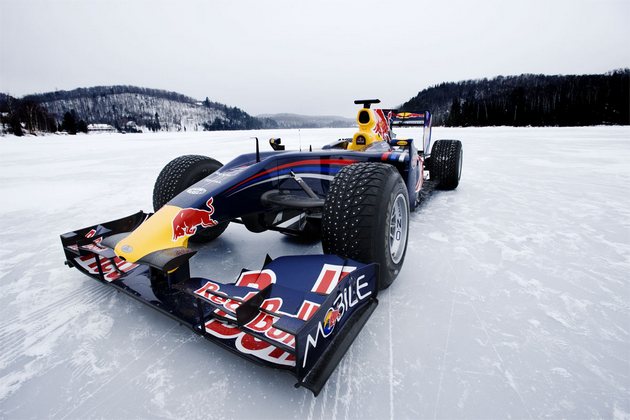
Many different flavors
Racing on ice has just about as much variety as that on dry land. You'll find speedway bikes on ferocious looking studs, snowmobile drag races and lots of other home-built contraptions flying across the lakes. There are plenty of international winter rallies with frozen stages, and in France ice racing is so popular that the Andros Trophy series lured Alain Prost out of retirement to pilot ridiculous 350-hp machines with both four-wheel drive and four-wheel steering.
Things tend to be a bit more amateur here in the Americas, with little professional support and no real nation-wide series to speak of. That means rules and regulations vary wildly as you go from club to club, with the most common type of ice racing being time trial events; effectively autocrosses with less grip and more snowbanks. These are a fun and (generally) risk-free way to experience the joys of endless four-wheel drifts at 15 mph, and they help make driving in the craziest of blizzards seem like just another boring commute.
The video meant to be presented here is no longer available. Sorry for the inconvenience.
AMEC
Autocrossing on ice is fun, but there are some clubs that take things a little further, and one of the oldest is AMEC, the Adirondack Motor Enthusiasts Club. The club dabbles in multiple types of motorsport, but its website address tells the focus: www.icerace.com. Since 1954 AMEC has been organizing events on lakes in and around Adirondack Park in Upstate, NY, developing a series of classes and rules that allow for newbies to arrive and drive on the ice while also making room for more experienced competitors to move up to purpose-built machinery. The following is a list of the primary classes, starting with the slowest.
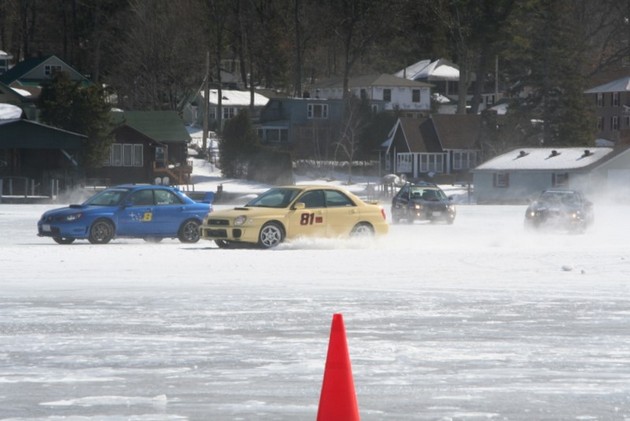
Street Legal (SL and SL4)
The SL cars are production machines that (surprise, surprise) must be street-legal. Very few modifications are allowed, generally limited to engine intake and exhaust along with mild suspension work. Air conditioning may be removed, but that's about it, and a maximum engine displacement of 3.8 liters means you can stop getting excited if you've been looking for something different to do with your Mustang this winter. Maximum weight is 3,200 lbs for two-wheel-drive cars (four-wheel-drive autos can be 200 lbs heavier), and all entrants must run non-modified dedicated snow tires. This means no studs, no "tractionizing" (chewing up the tire's surface), and absolutely no summer or all-season tires. Oh, and cars can't have any graffiti, and excessive rust is frowned upon too.
Some very nice cars show up and race in this class every week, including Subaru STIs and Mitsubishi EVOs. Contact is not allowed per the rules but this is wheel-to-wheel racing and it does happen. When fenders are dented, any competitor involved in a collision (even those not at fault) is immediately sent home – but they're free to come back next time. That said, collisions have traditionally been very rare, and the damage generally limited.
Stock Sportsman (SS)
The SS class is a new addition in the 2010 season, designed to be something of a stepping-stone to the higher Modified classes. Here cars must be production based, front-wheel-drive machines with a maximum of 2.5 liters of displacement (no forced induction). No major engine mods are allowed but cars can now run studded rubber, either used Menard tires with some studs removed or custom-made tires with a maximum of 25 studs per foot of tire, each stud having a maximum width and height of .25-inch.
What's a Menard? It's a special type of tire for ice racing with rows of beefy metal protrusions, shown on the yellow Citroen pictured below. SS cars can only run hand-me-down rubber if they're going with Menards, and even then must remove the outer rows of studs. Despite that, speeds are much higher here than in the SL classes, so a six-point cage and four-point harness are required. However, a windshield is not, meaning this is the class for you if you want the fully refreshing in your face ice racing experience at minimal cost.
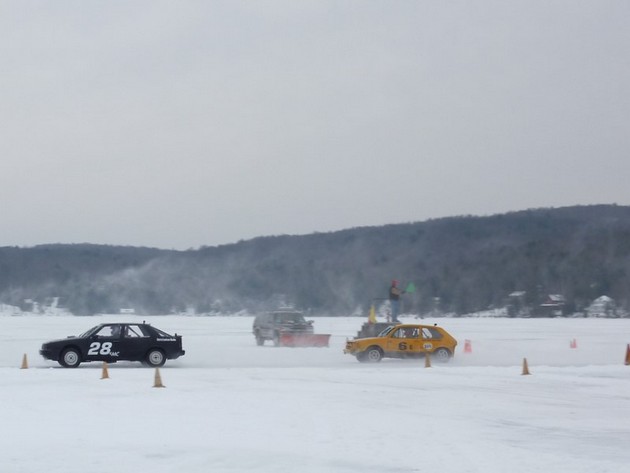
Modified (MM)
Modified takes things a bit further, allowing for extensive engine modifications and like-manufacturer motor swaps – you can take a base Rabbit and throw in a 16v GTI motor if you like. Competitors here (and in the faster classes) can now run new Menards, and at over $200 per tire it's not unusual for the rubber to be worth more than the car. Competitors can also try to make their own "experimental" studded tires, but they must be approved. Six point cages and four-point harnesses are again required, and you can now strip much of the interior away.
Super Modified Closed (SMC) - aka Class B
Getting even faster now, with a production-based chassis and bodywork but with many more choices on the engine modification list, up to and including full swaps for anything you like – even forced induction. Four-wheel drive autos are allowed in this class, the first since SL4.
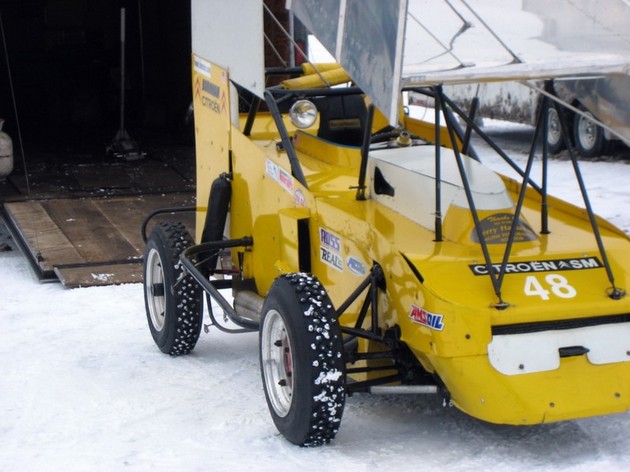
Super Modified Open (SMO) - aka Class A
These are the big boys; machines that in some cases are built on production chassis but can be completely custom built. They tend to look like sprint cars (above) with their giant wings, and have a minimum weight of just 1,000 lbs. Suspension and engine are more or less open, resulting in speeds well into the triple-digits.
Open Class
Have something that doesn't fit anywhere above? This is the catch-all, "run what ya' brung" class. Just don't expect a shiny trophy at the end of the day...
General Rules
In addition to all the above there are some rules that apply to all classes. Here are the highlights:
- No white or lightly colored vehicles (Exceptions might be made if you take steps to increase the visibility: orange graphics, etc.)
- Highly visible numbers (on the doors, front and rear windshield in SL)
- Snell 2000 rated helmet
- A maximum sound output of 95dB
- A fire extinguisher mounted within reach of the driver, fastened with a metal loop and clasp
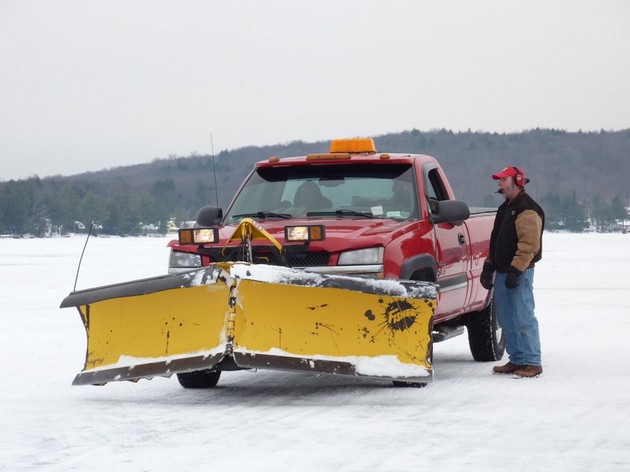
The tracks
Surely by now you're wondering just what sort of courses the club races on, and if you're a fan of variety you'll love this, as it's a new course every week with the size and shape generally dictated by conditions. Of late winters haven't been as conducive to ice production as in the past, which has meant frozen lakes can be a bit harder to come by. But, the club has been granted permission to run at a number of bodies of water in and around the Adirondacks, places like Tupper Lake, Caroga Lake, Lake Algonquin, and even Lake George at the town's annual Winter Carnival. They are proper circuits with both right- and left-hand turns, though those corners tend to be of the fast, sweeping variety (Tilke would not be impressed). Courses are also far, far wider than you'd find at your average road course, which helps to reduce the likelihood of collisions.
The courses are created by a team of tireless volunteers, many of whom drive their own trucks to the lakes and spend hours plowing out the courses, pits and parking areas. But, before any of that happens AMEC representatives check the lake, drilling numerous test holes on the days leading up to any event to ensure that ice conditions are good – namely that there's at least 12-inches of solid stuff throughout. Any less and racing doesn't happen. Period. That's a lot of very buoyant material, capable of holding up the hundreds of vehicles you'll typically see parked out on the lake any given race weekend.
Yes, hundreds.
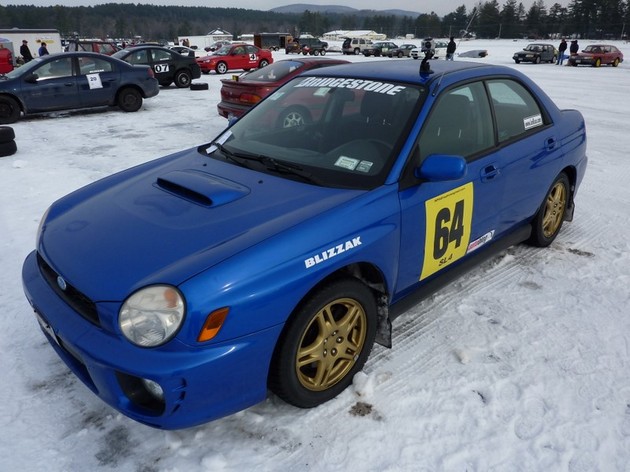
What's next?
If you hadn't guessed by now we'll be going racing with AMEC this winter, taking you along for an experience unlike anything else in the motorsports world. Sure, it looks a little like drifting, but here you don't get any of the nasty tire smoke – and you lose a lot of the pretenses, too. We'll be running a Subaru in the SL4 class and we'll walk you through car preparation, talk driving techniques, then bring you along to the lakes so that you can see how we do. You won't even need to get on your long johns, unless you feel like being extra cozy at home.
If you're the impatient type and want to try it yourself right now you can check out www.icerace.com to get updates on AMEC's current schedule (which changes frequently). A little further east the Jackson family puts on a series of ice autocrosses in New Hampshire that are generally listed on the Boston BMW Club's website. In the mid-west there's the Michigan Ice Racing Association, north of the border check out Motorsport Club of Ottawa and and Thunder Bay Autosport Club, and there are many, many more clubs around the world that will be hitting the ice this season.
What if you live somewhere warm? Well, why don't you go ahead and take a nice January drive on your summer tires with the windows down and try not to feel too sorry for yourself – but please do feel free to check in next week if you want to live vicariously.
Update: You can read parts two, three, and four from here, each with plenty of in-car footage from the ice!



Sign in to post
Please sign in to leave a comment.
Continue